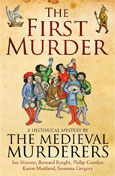 1154, Oseney Priory, Oxford.
1154, Oseney Priory, Oxford.
When the first performance of The Play of Adam ends in tragedy, the author is compelled to pen a grim warning for the generations that follow:
BEWARE THE SINS OF ENVY AND VAINGLORY, ELSE FOUL MURDER ENDS YOUR STORY.
But his words are not heeded, and as the play is performed in many guises throughout the ages, bad luck seems to follow after those involved in its production.
When a snow storm diverts two disparate parties of travellers to the busy market town of Carmarthen in the winter of 1199, an enigmatic stranger appears and requests to stage the play to alleviate tensions, but on the eve of the performance the actor chosen to play Cain is found dead.
When the play is performed in the city of Ely in 1361, the townspeople fear the play has unleashed a demon upon the town after a gruesome discovery is made in the Cathedral. And from Shakespeare’s London to war-time Surrey, no matter the time or the place, each production always seems to end in disaster.
Perhaps it is simply the curse of thespian rivalry that is to blame. Or does the story of man’s first murder somehow infect all who re-enact it?
Amazon.co.ukHardcoverKindle Edition
Amazon.comHardcoverUS Kindle Edition
Prologue: In which Ian Morson explains how The Play of Adam first earns its evil reputation.
Act One: In which Susanna Gregory tells how a sudden snowstorm in December 1199 strands rival bands of clerics in Carmarthen. They stage the play as entertainment – and murder and mayhem soon follow.
Act Two: In which Karen Maitland relates how the play goes to Ely in 1361, but the murder of a player swiftly follows.
Act Three: In which Philip Gooden describes how an embittered rival to Shakespeare sets about wreaking havoc in 1606, but is soon found dead in his bookshop.
Act Four: In which Ian Morson relates how the play is used for political ends in 1820s Oxford.
Epilogue: In which Bernard Knight brings the play’s deadly history up to date with a modern twist.

